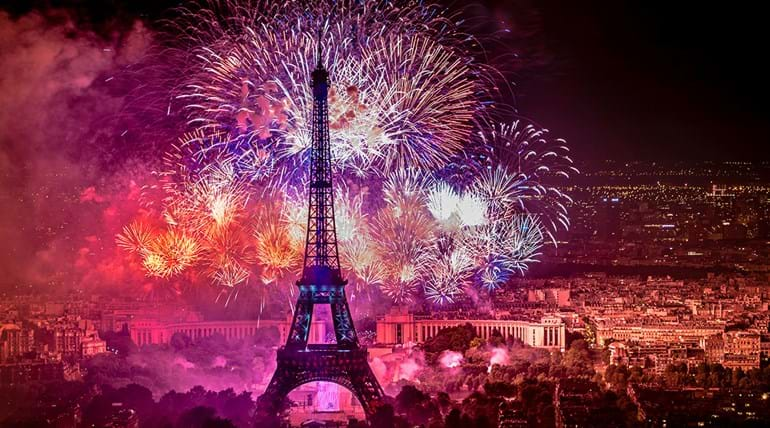It’s worth noting that only 10 days separate the Fourth of July (or, as we sometimes call it over here, “Independence Day”) from Bastille Day (or, as they call it over there, “la Fête nationale“ and “le 14 juillet”).
In America, the signing of the Declaration made for an official stamp of war against a royal tyrant and the government of Great Britain, while in France, the storming of the Bastille was the spark of a revolution that remade French society.
In America, the revolution became a long war that ended in independence from the British Crown and a new country calling itself the United States of America. In France, the revolution — radical, violent, destructive — ended in the execution of a king and queen and a revolutionary government which spread its spirit across Europe. (It ended, however, with the installation of Napoleon Bonaparte as emperor, not a small irony.)
The critical aid of France to the American colonies, with monetary assistance, training, materiel and naval forces, almost bankrupted its own monarchy and almost certainly led to the events of 1789.
History is important in this relationship. The Marquis de Lafayette, who commanded American troops in our revolution, returned in 1824, and toured the budding American democracy to rock-star-like acclaim. In 1917, during the Great War, when thousands of American troops came to assist the French and English along the Western Front in France, Gen. Pershing’s aide Charles Stanton said, as if repaying the favor: “Lafayette, we are here!”
There is another tie between us: the Statue of Liberty. This generous gift from France, sculpted by Frédéric Auguste Bartholdi and titled “Liberty Enlightening the World,” became an open invitation to newcomers and immigrants, torch held high, with a plaque on which the words of Emma Lazarus’s poem “The New Colossus” were cast: “Give me your tired, your poor, Your huddled masses yearning to breathe free, The wretched refuse of your teeming shore.”
But it’s also true that, in celebrating Bastille Day with the French people in Washington, we share something else, especially in Washington, D.C., and Georgetown. That is an unabashed admiration and embrace of almost all things French: its culture, its domination of and expression of couture and style, its literature, music, painters, its makers of cinema, its language (even though most Americans can’t speak it), its grandiosity and totality and sometimes its pomposity, too.
In French, everything, and we mean everything, sounds just so much better.
We love the food, remembering it from the highbrow Rive Gauche here, in the more down-to-earth Au Pied de Cochon and its counterpart Restaurant de Fruits de Mer, all departed. Somewhere on Pennsylvania Avenue, there was a place that did frog legs, which you should have at least once in your life, soaked in butter and pity for the poor frogs.
French leaders, politics and history has always been writ large and old, which still makes Americans look like the new kids on the block at times. We stayed in a hotel for which the view included a church built in the 900s. The Sun King (“La France, c’est moi”); le Grand Charles, whom we saw in full uniform marching in his solemn grandness at JFK’s funeral; French paintings, especially Renoir’s picnickers (“Luncheon of the Boating Party”) in the Phillips Collection; Samuel Beckett living in France writing his plays (“En attendant Godot”) in French; and boyhood stories and movies of Quasimodo, the three-plus-one musketeers and so forth.
We love French movies, pretty much all of them, but especially “Jules et Jim,” “Breathless” (originally “À bout de souffle”) and “Au revoir les enfants,” along with anything with Jeanne Moreau and Catherine Deneuve and the sound of Charles Boyer as Napoleon.
That and so many other reasons is why some of us cried when we saw the fiery collapses at Notre-Dame de Paris.
We say today and any other day: Vive la France! Nous vous aimons!


